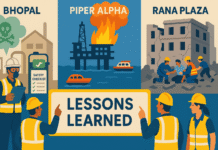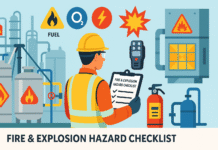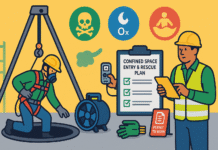
Hot Work Risk Assessment
A hot work risk assessment is a structured way to identify these fire hazards, evaluate the level of risk, and take action to control or eliminate it. Think of it as your fire prevention playbook — one wrong move, and a small spark could become a disaster.
Hot work refers to any activity that generates heat, sparks, or flames — like welding, cutting, grinding, or soldering. These tasks are common but extremely risky, especially when done near flammable materials.
A hot work risk assessment is a structured way to identify these fire hazards, evaluate the level of risk, and take action to control or eliminate it. Think of it as your fire prevention playbook — one wrong move, and a small spark could become a disaster.
Legal Guidelines and Compliance
OSHA Regulations for Hot Work
Under OSHA 29 CFR 1910 Subpart Q, employers must ensure hot work is performed safely, with permits, supervision, and fire protection.
NFPA 51B – Standard for Fire Prevention
NFPA 51B is the gold standard for managing hot work operations — including the permit system, fire watch, and post-work inspections.
UK HSE and Indian Fire Safety Laws
The UK HSE requires fire risk assessments under the Regulatory Reform (Fire Safety) Order 2005. In India, NBC Part 4 outlines fire safety practices, while Factories Act 1948 mandates risk controls for welding and cutting.
Types of Hot Work
Welding and Cutting
Produces intense heat and sparks. Often done in industrial settings — high fire risk.
Grinding and Brazing
Grinding can generate sparks over long distances. Brazing uses a torch that can ignite flammables quickly.
Soldering and Torch Use
Even low-temp torches can start fires if used carelessly or near dry materials.
Common Hazards in Hot Work
Fire and Explosion
Flammable vapors or materials in the area can catch fire instantly from a stray spark.
Burns and Heat Exposure
Workers face risks of severe burns, especially without proper PPE.
Toxic Fumes and Gases
Welding fumes, especially in enclosed areas, can contain heavy metals and irritants.
Flying Sparks and Molten Metal
Sparks can travel up to 35 feet — igniting nearby materials or harming bystanders.
Oxygen-Enriched Environments
Even a small oxygen leak can turn a safe zone into a blast zone. Always check cylinders and hoses.
When is a Hot Work Risk Assessment Required?
Non-designated Hot Work Areas
If work is done outside a certified hot work room, you must assess the area for fire risk.
Confined Spaces
Sparks, fumes, and limited escape routes make confined space hot work highly dangerous.
Near Flammable Materials
Wood, fuel, chemicals, or paper — anything combustible near the job site requires risk evaluation.
Components of a Hot Work Risk Assessment
Step 1 – Identify Hazards
Review materials, tools, work environment, and fire risks.
Step 2 – Determine Who May Be Harmed
Welders, helpers, nearby workers, and even passersby may be at risk.
Step 3 – Evaluate the Risk and Control Measures
Can the fire risk be minimized with barriers, isolation, or scheduling work at safe times?
Step 4 – Document and Communicate the Plan
Include a Hot Work Permit, emergency contact numbers, and fire safety measures.
Step 5 – Monitor and Review Regularly
Check daily. After a fire near-miss, always update the assessment.
Control Measures in Hot Work
Hot Work Permit System
No permit = No work. Ensure it includes inspection, authorized personnel, and expiry time.
Fire Watch Personnel
Trained watchers must stay on-site during and after hot work (usually for 30 minutes).
Use of Fire Blankets and Barriers
Use to isolate hot work from nearby combustibles or walls.
Ventilation and Gas Monitoring
Ensure proper airflow and check for dangerous gases with detectors.
Emergency Procedures and Firefighting Equipment
Have extinguishers, fire alarms, and an evacuation plan ready.
Hierarchy of Controls for Hot Work
Eliminate – Use Cold Work Methods
Can the task be done using bolting or mechanical joints instead of welding?
Substitute – Use Prefabricated Components
Assemble off-site to reduce fire risk on-site.
Engineering Controls – Screens, Spark Containment
Welding curtains, spark traps, and flashback arrestors help contain hazards.
Administrative Controls – Permit System, Training
Ensure all workers are certified, and fire safety rules are strictly enforced.
PPE – Welding Helmets, Gloves, Flame-Resistant Clothing
These protect workers from radiant heat, sparks, and spatter.
Hot Work Safety Tips
Pre-Work Inspections
Inspect equipment, area cleanliness, flammables, and fire extinguishers.
Clear the Work Area
Move any flammable material at least 35 feet away — or shield it.
Ensure Continuous Fire Watch
The fire watch must remain during and after the job, watching for hidden embers.
Hot Work Risk Assessment Template
Essential Fields and Format
- Description of hot work task
- Location
- Equipment used
- Identified hazards
- Fire control measures
- PPE used
- Permit number and expiry
- Fire watch assignment
- Emergency procedures
How to Use It On-Site
Make it part of the permit-to-work system. Review it during toolbox talks. Keep one copy at the site and another with the supervisor.
Hot Work – Risk Assessment
General Information
- Project/Site Name: XYZ Engineering Pvt. Ltd. – Structural Fabrication Yard
- Assessment Title: Hot Work Risk Assessment
- Location: Workshop Bay 2 – Welding and Cutting Area
- Assessed By: Mahendra Lanjewar (Safety Officer)
- Assessment Date: 01 July 2025
- Review Date: 01 October 2025
- Activity Description: Gas cutting, welding, and grinding of steel components inside fabrication workshop
Hot Work Risk Assessment Table
| Task | Hazards Identified | Persons at Risk | Risk Rating (Before Control) | Control Measures | Risk Rating (After Control) | Responsible Person |
|---|---|---|---|---|---|---|
| 1. Welding metal plates | Fire or explosion due to sparks near flammable materials | Welders, nearby workers | High | – Remove flammable materials from area – Use fire blankets/screens – Issue Hot Work Permit – Appoint fire watch during and after work | Low | Safety Officer / Welder |
| 2. Gas cutting with oxy-acetylene | Explosion due to gas leakage or backfire | Cutting operator, nearby workers | High | – Leak test before use – Flashback arrestors installed – Use in well-ventilated area – Secure cylinders upright with chain | Medium | Cutting Operator / Storekeeper |
| 3. Grinding steel beams | Eye and hand injuries from sparks or flying particles | Grinding operator | Medium | – Use face shield, goggles, gloves – Ensure grinder has guard – Check RPM compatibility of disc – No loose clothing | Low | Grinder Operator / Safety Officer |
| 4. Fire spread after hot work | Delayed ignition after work completion | All workshop staff | High | – Maintain 1-hour fire watch post-activity – Keep fire extinguisher and sand buckets nearby – Check area before leaving site | Low | Fire Watch / Supervisor |
| 5. Inhalation of fumes or poor ventilation | Respiratory issues due to welding/gas fumes | Welders, other nearby workers | Medium | – Use exhaust fans or smoke extractors – Provide appropriate masks/respirators – Conduct work outdoors when possible | Low | Safety Officer |
| 6. Electric shock during arc welding | Shock from faulty connections or wet surfaces | Welders | High | – Inspect welding cables and holders – Use dry gloves and mats – Avoid welding in wet areas | Low | Electrical Supervisor / Welder |
Risk Rating Matrix
| Severity | Likelihood | Risk Rating |
|---|---|---|
| 1 – Minor injury | 1 – Unlikely | Low |
| 2 – Lost time injury | 2 – Possible | Medium |
| 3 – Major/fatal injury | 3 – Likely | High |
Note: Risk rating = Severity × Likelihood
Additional Notes
- Permit to Work: Hot Work Permit is mandatory for any welding, cutting, or grinding activity.
- Fire Watch: Required during work and for minimum 60 minutes after work ends.
- PPE Required: Welding shield, face shield, goggles, fire-resistant gloves, leather apron, safety shoes, respiratory mask.
- Toolbox Talk: Conducted daily before hot work begins.
Review and Sign-Off
| Name | Designation | Signature | Date |
|---|---|---|---|
| Rupesh Wasnik | Safety Officer | [Signature] | 01-07-2025 |
| Ashok Mehta | Workshop In-charge | [Signature] | 01-07-2025 |
| Sanjay Yadav | Fire Watch | [Signature] | 01-07-2025 |
Conclusion
Hot work can spark innovation — or destruction. A hot work risk assessment is your first defense against fire, injury, and loss. It’s not about delaying the job — it’s about doing it right, doing it safe, and ensuring everyone goes home. No shortcuts, no assumptions — just solid planning and sharp awareness. Because where there’s fire, there must be focus.
Work at Height Risk Assessment
4 Steps of Job Safety Analysis (JSA)
Risk Management 101: Conducting Effective Risk Assessments
Risk Matrix vs Risk Assessment: What’s the Difference?
How to Create an Effective Risk Matrix for Your Workplace
FAQs
1. What activities require a hot work permit?
Any task that involves open flames, heat, or sparks — like welding, cutting, or grinding.
2. Who is responsible for issuing a hot work permit?
A trained and authorized permit issuer, typically the safety officer or site manager.
3. How long should a fire watch remain after hot work is complete?
Usually 30 minutes minimum — but may extend up to 2 hours in high-risk areas.
4. Is PPE mandatory during hot work?
Absolutely. Welding shields, gloves, flame-resistant clothing, and safety shoes are essential.
5. Can hot work be done near flammable liquids?
Not safely — unless the liquids are removed or properly shielded and the area is monitored continuously.
























